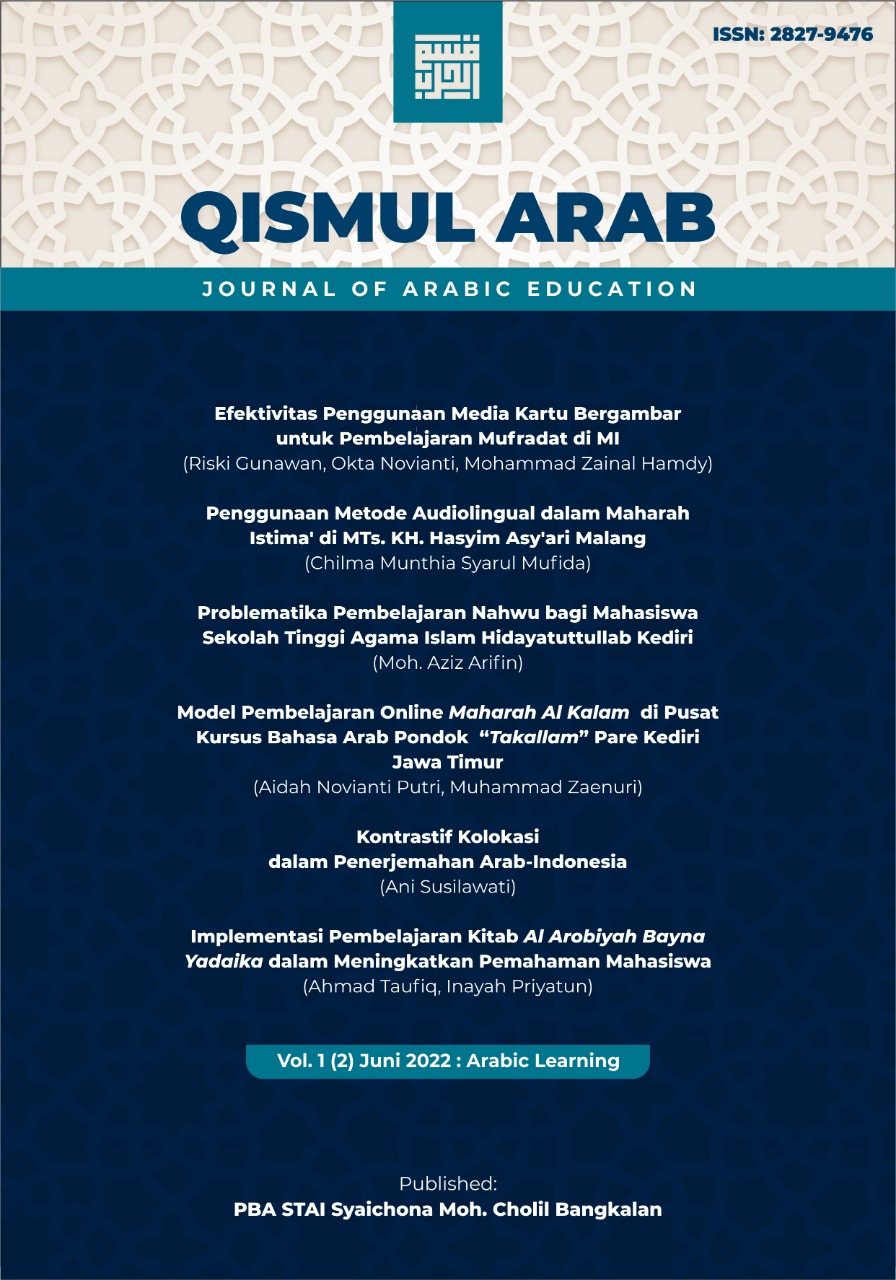Kontrastif Kolokasi dalam Penerjemahan Arab-Indonesia
DOI:
https://doi.org/10.62730/qismularab.v1i02.13Abstract
The comparative study conducted in this research is to see the differences and similarities between Arabic and Indonesian collocations and to see how the collocation process is translated. The comparative study was conducted using a comparative descriptive methodological approach. This research is a type of library research, which describes research conducted solely based on facts or phenomena contained in the data. The data processing process is carried out using three steps of contrastive analysis, the first is a description, the second is an overview and the third is a comparison as well as describes the collocation process in translation. Through these several stages, lexical and grammatical collocation data can be obtained both in Arabic and Indonesian as follows: words that are side by side or side by side between prepositions and verbs where the prepositions used are the prepositions (fî), ??(ilâ)??? (alâ), (an), ?(li) and (bi), resulting in the form or category of verb + preposition. Meanwhile, lexical collocations in Arabic use noun + noun, adjective + noun, verb + noun, preposition + noun and Indonesian lexical and grammatical collocations take the form of subject + predicate, noun + adjective, noun + noun, noun + adjective, noun + noun, verb + noun, adjective + noun. Furthermore, in the translation process, the lexical and grammatical collocation forms from the two languages cannot be translated literally or word for word (as is) but must be translated according to the context of the sentence and the culture used in the language.
References
Ali, Atabik, Muhdlor, A. Zuhdi. Kamus Kontemporer Arab Indonesia. Yogyakarta: Multi Karya Grafika, 1998.
Astuti, Purwani Indri. “Kolokasi Di Bidang Penerjemahan.” Magister Scientiae 0, no. 36 (2014): 113–122. http://jurnal.wima.ac.id/index.php/Magister_Scientiae/article/view/622.
Basuni Imamuddin & Nashiroh Ishaq. Kamus Idiom Arab-Indonesia Pola Aktif, 2019.
Imran, Indiyah, Mashadi Said, and Ni Luh Putu Setiarini. “Kolokasi Bahasa Indonesia.” Proceeding PESAT (Psikologi, Ekonomi, Sastra, Arsitektur & Sipil) 3 (2009): 27–33.
Lado Robert. Lingusitik A Cross Culture, 1959.
Misdawati, Misdawati. “Analisis Kontrastif Dalam Pembelajaran Bahasa.” `A Jamiy?: Jurnal Bahasa dan Sastra Arab 8, no. 1 (2019): 53.
Mona Baker. In Other Words a Coursebook on Translation. London and New York, 1992.
Muhammad Luqman Ibnul Hakim, Muhammad Zaidi, Mohd Sollah, and Nabihah. “Struktur Dan Konteks Kolokasi Frasa Al- ID?FATT Dalam Al-Quran?: Satu Pemerhatian Semantik.” Journal of Education and Social Sciences 1, no. Jun (2015): 137–149.
Munip, Abdul. “Problematika Penerjemahan Bahasa Arab Ke Bahasa Indonesia?; Suatu Pendekatan Error Analysis.” Al-’Arabiyah Vol. 1, no. No. 2 (2010): 1–14.
Nur, Tajudin. “Analisis Kontrastif Dalam Studi Bahasa.” Arabi?: Journal of Arabic Studies 1, no. 2 (2016): 64.
Prasetyani, Nuning Yudhi. “Analisis Kontrastif Dalam Penerjemahan ‘ Sightseeing ’” (n.d.).
Shalihah, Siti. “Menerjemahkan Bahasa Arab: Antara Ilmu Dan Seni.” At-Ta’dib 12, no. 1 (2017): 157.
Yuslin Kasan. “Struktur Kolokasi Bahasa Arab (Suatu Kajian Fenomena Linguistik)” 4 (2019): 223–238.
Downloads
Published
How to Cite
Issue
Section
License
Copyright (c) 2022 Ani Susilawati

This work is licensed under a Creative Commons Attribution 4.0 International License.






